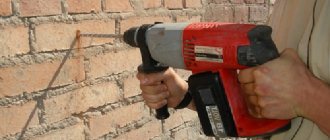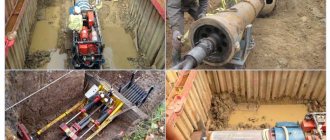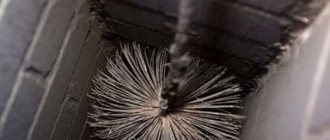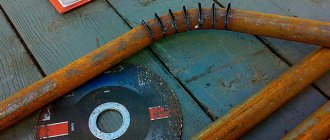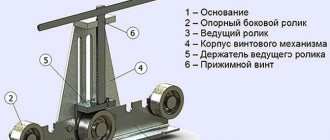When carrying out renovation construction work, it is often necessary to lay technical communications in the walls. In this case, the walls for the pipes are chipped with a special construction tool using various technologies.
These works are accompanied by a large amount of debris and intense dust, so special dust control methods are used when performing them. When carrying out apartment renovations with your own hands, related to the installation or transfer of plumbing equipment, it is important to know how to properly groove walls for pipes.
Rice. 1 Cutting through a concrete wall for wiring with a wall chaser
Basic requirements for hidden communications
Construction codes and regulations, which include the normative document SNiP 2.04.01-85, regulate the rules for the location of water pipes in the walls - it is useful to know them when carrying out installation work. The documentary acts indicate the following basic standards for the installation of water lines in the walls:
- It is prohibited to chip load-bearing walls, as this reduces their strength and, accordingly, leads to a decrease in the stability of the entire structure.
- Only solid structures connected by soldering or welding are allowed to be laid in walls. If the connection is removable, access to it is provided by installing inspection hatches or removable panels.
- When laying a pipeline from metal-plastic or metal elements, the placement of electrical wiring should be taken into account; during gating, the electrical line at the work site must be de-energized.
- The groove must be laid taking into account the expansion of the pipeline material when heated; its depth and width are calculated to maximize the increase in the diameter of the passing pipes. It is recommended to install a compensating junction for every 3 linear meters of pipes carrying hot water.
Rice. 2 Example of performing gating with a hammer drill
- The pipes are secured using clamps; during installation, the pipeline should not come into contact with the walls of the channel - this contributes to the appearance of extraneous sounds during operation.
- It is recommended that the hot water supply pipeline placed inside the walls be placed in a heat insulator (Energoflex) to reduce heat loss in the line.
- When sealing the grooves, the material should not be heavily compacted; it is advisable to leave air cavities in the event of linear expansion of the pipes.
Concrete surface
It is recommended to use a hammer drill. A grinder is also used when working with concrete, but to cut this material you will need a diamond disc; a regular one for stone will be ineffective.
- At the first stage, the surface is marked taking into account existing communications.
- Then holes are made along the length of the furrow to the entire expected depth in increments of 10–15 cm, or the boundaries of the canal are cut with a grinder.
- A perforator is used to hammer out the concrete from the groove.
Work plan for installing pipelines into walls
It is advisable to perform operations with pipes, such as placing them in walls, in the following order:
- Planning with the development of a pipeline diagram and drawing up a line drawing indicating dimensions.
- Marking the walls using a construction pencil and level. In this case, two lines are applied to the surface corresponding to the width of the channel.
- Grilling walls to the required depth in compliance with safety regulations.
- Cleaning the channel from dirt and dust, laying and fastening pipes using clamps.
- Connecting the pipeline to the system and checking its functionality, if possible, conducting test tests with increased pressure.
- Sealing the channel with building materials: to improve adhesion and adhesion, it is wetted; usually the putty is done using quick-drying dry mixtures based on gypsum, which are diluted in water.
- Finishing the wall with decorative finishing materials.
Rice. 3 Scoring tool
Attention to protective equipment
It is very important to use protective equipment during work. During the cutting process, a lot of dust and sand are released, and stones can also break off. To avoid injury or health problems, use the following equipment:
- protective glasses;
- respirator;
- gloves;
- closed clothes.
In addition to protective equipment, it is very important to follow safety rules:
- load-bearing walls are a risk area in panel-type houses (it is not always possible to ditch them);
- deformation of the reinforcement frame of reinforced concrete structures is strictly prohibited;
- in concrete walls, it is advisable to groove the walls not deeply and in a vertical direction;
- you should not carry out any operations in walls with deformed reinforcement, as this will only increase the risk of collapse;
- pay attention to electrical wiring.
Grilling technology using various construction tools
When deciding how to groove a wall in the bathroom for pipes or make channels in the floor to run hot heating pipelines through, they resort to dismantling work using the following methods and tools.
Hammer and chisel
An old-fashioned method, suitable for working on walls made of soft building materials (gas silicate blocks, foam concrete, gypsum plaster). During installation, at the beginning, special grooves are knocked out along two lines of the channel with a depth of about 10 mm, then the material is removed between the punched lines, after which the operation is repeated many times until the desired depth is obtained.
Advantages of types of grooves for pipe wiring
In order to increase living space and achieve a neat effect, it is necessary to hide as much as possible in the walls all communications laid inside the house or apartment. There are several ways to mask pipes:
- behind false walls, ceilings, floors.
- in decorative boxes.
When building a house or remodeling an apartment, you can initially lay pipes inside walls, partitions or in the floor without subsequent gating. In the case of finished buildings without communications laid inside, it is necessary to make special grooves. The process of making such grooves is called gating.
To simplify the process of slitting with your own hands, you need to study the following questions:
- In what areas are furrows allowed to be made?
- What are the features of gating in narrow spaces?
- What can be laid in the walls?
- What's the best way to do this kind of work?
Wall chaser
A wall chaser is a tool specially designed for chasing wires. Its design is similar to an angle grinder, only instead of one disc you can use two simultaneously working ones - this allows you to cut a channel of the required width in one pass. Unlike an angle grinder, the wall chaser is provided with protection from dust - for this purpose, there is a pipe on the protective cover for connecting the suction pipes of a construction vacuum cleaner. In the device, you can adjust the distance between the located disks, thereby setting the width of the groove and the depth of the cut.
To lay a pipeline in the walls, wide channels are required, for which the inter-disk distance of the wall chaser is not always designed - then only one disk is installed in the tool, and the work of cutting through the walls is carried out in two stages, similar to using a grinder.
Rice. 5 Wall chasers
What SNiP says
In addition, SNiP has a direct prohibition on interfering with the design of the ceiling slab. There are no additional conditions regarding direction or depth, and any interference is prohibited. Therefore, if you plan to groove the floor for sewerage, you must first inspect its structure. In panel houses, the suncabin is installed on its own concrete supporting surface, which is not directly the floor slab. Therefore, it is possible to make a recess that does not exceed the thickness of the additional slab. However, if you need to hide pipes with a diameter of 110 mm or more, you will have to make a corresponding trench. It will inevitably touch the ceiling slab, which is prohibited by regulations.
Some owners of apartments or private houses are trying to get out of the situation by using smaller pipes. For example, instead of the usual 50 mm, 40 or even 30 mm lines are installed. This is possible, but each type of plumbing has its own limitation on the diameter of the drainage system. For example, bathtub drains carry large amounts of hair, which quickly clogs. If you reduce the size of the pipes, blockages will have to be cleared more often. Considering the hidden way of placing the system, you can create a big problem for yourself.
Making walls for pipes with your own hands
After drawing up a plan for the placement of the pipeline, taking into account the fact that all branches and changes in direction in the line are carried out at right angles, begin marking. The work is performed in the following sequence:
- Checks for the presence of hidden wiring at the work site; if there is no layout diagram, you can use a special device to search for wires.
- Using a construction pencil and a level, two lines are drawn on the wall, corresponding to the width of the pipes with a small margin. If a heat insulator is used on a hot water pipeline, increase the width of the channel accordingly.
After marking work is completed, you can measure the total length of the channel and most accurately determine the required length of pipes in the line.
- Once you have finished marking the walls using a building level, tape measure and pencil, you can begin grooving; the above tools are used when carrying out the work.
If gating is necessary, there are several options for how to most effectively carry out this procedure; to carry out the work you can:
- Use the services of hired specialists; the cost of one linear meter of groove, depending on its parameters, wall material and region, fluctuates within 5 USD. per linear meter.
- If you don’t have the necessary tool, you can rent it and do the work yourself, saving some money.
- If you have your own hammer drill and the necessary attachments for it, you can drill the wall yourself using only this tool. If you only have a grinder, use it to cut through the wall, and you will have to knock out the material manually using a chisel and hammer.
Advice from professionals
- Grilling is rough work, and it is performed according to certain rules. For example, the grooves should be located exclusively vertically or horizontally.
- Pipes can only be connected to each other using a monolithic welding technique. If the communications were connected using dismountable fittings, inspection windows should be left.
- Even if you are sure that there are no hidden electrical wires in the wall, you should turn off the power to the section of the wall that you plan to work with. The grooves must be larger in width than the pipes themselves and their fastenings. The coefficient of expansion of the material is insignificant for metal communications and polymer pipes reinforced with aluminum.
- It is important to prevent the pipes from coming into contact with the groove walls. For this purpose, communications are secured with clamps. This requirement should be taken especially seriously if the system has many bends. Failure to comply with this rule will lead to excessive noise during the operation of the water supply or sewerage system.
- It is important to prevent tight contact of the material for finishing the groove with the elbow. The groove must be sealed in such a way that an air gap is formed inside. Filling the space with material is a mistake.
- After the channel has been created, and the material inside has been selected, its cavity must be thoroughly cleaned and dust-free.
- The start-up of communications is carried out even before decorating the groove in order to check the system for leaks.
- Be sure to leave inspection holes, which will be needed if the system needs to be repaired or replaced.
- You should not rely on a chisel and a hammer if you have to work with a solid concrete wall in which you need to make grooves of considerable length.
When working with an angle grinder, you should not overdo it and do not put too much pressure on the tool. Otherwise, you may encounter the equipment overheating and failure, and the equipment may become unusable.
Grinding concrete walls in panel houses with a grinder
Using a grinder, you get a groove with neat, even edges - this makes further placement of the pipeline in the channel easier, and its use significantly increases the speed of work. The scoring procedure using a grinder consists of the following steps:
- Place a diamond-coated concrete disc on the grinder and cut the wall strictly along the line to the required depth, not forgetting to use dust protection during work.
- Using a hammer drill with a spade attachment or a chisel and hammer, knock out the concrete between the cut grooves. When carrying out work, control the deepening of the groove with a piece of pipe, trying to maintain a depth of at least 5 mm. from the plane of the wall.
If the channels for the pipes are large, you can use a grinder to make one or two additional cuts in the middle - this will make it much easier to further knock out the concrete not only with a chisel, but also with a hammer drill.
- After the work is completed, the channel is cleaned of dirt and dust accumulated in it using a brush; before sealing with gypsum binder, the surface of the groove is moistened.
Rice. 7 How to make grooves for pipes when using a hammer drill
What kind of walls can be tiled?
A frequent and well-founded question is: is it possible to trench load-bearing walls in a monolithic house for sewerage? Searching for information on this matter is very difficult, since there is no special section in regulatory documents on this matter. However, SNiP has a direct instruction in this regard - only vertical channels with a depth of no more than 20 mm can be tapped. For hidden installation, it is necessary to make horizontal routes, the depth of which should exceed the diameter of the pipes by approximately 5 mm. This means that hidden installation of drainage lines in supporting structures is impossible. However, the sewerage system is rarely located along the outer planes. For example, gating of walls in a panel house for sewerage is most often done along the longitudinal partition of the sanitary cabin. It is not a load-bearing element, so driving a route for laying pipelines in it is permitted.
The reason for limiting the depth of the groove lies in the structure of the slabs. The reinforcement frame is located under a protective concrete layer, the thickness of which on the load-bearing planes reaches 3 cm. If you go deeper, you will have to cut the reinforcement, which will weaken the structure and reduce the ability to withstand work loads. Such a wall will begin to sag, cracks and deformations will appear. It is difficult to predict how this might turn out, but there is a lot of information on the Internet about house collapses due to a violation of the strength of load-bearing structures.
Shredding brick walls with a hammer drill
A hammer drill is a universal construction tool that can be used to drill holes and knock out hard materials - thanks to these properties, the tool can quite effectively knock out channels for water supply or heating pipes. The work order is as follows:
- Pobedit drill for concrete with a diameter of 8 or 10 mm. in perforation mode, it makes a series of holes of the required depth along the entire length of two lines, the step can be chosen arbitrarily, but the smaller the distance between the holes, the better the quality of the groove edges.
- Next, insert a shovel-shaped attachment into the hammer drill, switching it to impact mode, and knock the brick between the drilled grooves, controlling the depth with a pipe section.
- Upon completion of the work, the groove is cleaned of dust and foreign debris; for this you can use a household vacuum cleaner.
Rice. 8 Angle grinding machine used for scoring walls for pipes with two discs
The basic principle
The basic principle of gating is to create a shallow “hole” into which a communication junction must be inserted. To do this, two parallel ones are made deep into the wall with a specialized construction tool (wall chaser) at a distance of 2.5 cm from each other. The depth is approximately the same, this is due to the diameter of the pipes (usually 20 mm).
After all the manipulations are completed, the hammer drill comes into operation. It is used to remove the internal filling between the slots.
Homemade wall chaser
A professional wall chaser is an expensive tool, and in terms of its operating principle and design it is practically no different from an angle grinder. This allows craftsmen to make some changes to the design of the angle grinder elements to effectively perform the gating functions.
Two disks. Installing two discs allows you to speed up work and improve its quality - the channel is cut in one pass, and its width is the same along its entire length. If the groove is narrow, the modification is quite simple - a second disk is placed on the grinder, the width of the groove is set by a washer installed between the disks. To increase the distance between the cutting wheels, you can make an attachment for an angle grinder on a lathe with a wider seat.
Fig.9 How to make furrows for water supply pipelines with a grinder without dust
Nozzle for vacuum cleaner. To combat dust, some craftsmen make a separate attachment for an angle grinder with a fitting for connecting a vacuum cleaner. To implement this improvement, soldering or welding work that is quite difficult for a non-specialist is required.
There is an easier way to deal with dust - tie a piece of water pipe to the handle of an angle grinder with masking tape and connect a vacuum cleaner to it.
The main tools for making walls for pipes with your own hands are a hammer drill and an angle grinder; a more expensive wall chaser is used when carrying out professional work in the construction industry. With your own hands, you can turn an angle grinder into an analogue of a wall chaser by making fairly simple changes in the design.
Preparatory work
Before installation of the pipeline begins, drawings of sewer pipes are drawn up. They are necessary for designing the most optimal ways to connect sanitary fixtures and performing accurate calculations of the required pipeline products.
In addition, the diagram will help determine how many fittings need to be purchased for the future sewer system. No special tools are needed to install a sewer pipeline. You can get by with a hacksaw, a file and a tape measure.
When purchasing pipe and shaped sewer products, it is imperative to ensure that all elements have sealing collars. The rubber bands must not have any damage, otherwise the tightness of the connection is not guaranteed.
The advantage of polypropylene material is that it can be monolithic.
That is, pipes and welded joints of polypropylene can be safely laid behind drywall, walled up under plaster, or laid in a groove in a wall or floor, and then safely lay tiles on top.
Polypropylene parts are soldered together using diffusion welding, in which the connection occurs at the molecular level. In your own words: a pipe soldered with a fitting is obtained as a single casting. This can be achieved provided that
Everything would be fine, but there is one hitch:
Polypropylene has high linear expansion, significantly high. For one linear meter, when heated, the pipe can increase in length up to fifteen millimeters. If you throw it straight, then this expansion will warp it and bend it in all directions. To avoid this, during installation it is necessary to provide compensating sections.
I note that polypropylene with cold water supply practically does not change in size. But what if you need to install ten or even more meters of pipe for hot water supply?
factory compensator
You can use a factory compensator, but when walling it up, for example, in a groove, this has its own difficulties - hollowing out the “tricks” is labor-intensive. In such cases, compensators that are made with bends are appropriate. If you make a meter compensator every three linear meters,
with a distance of twenty centimeters, there will be no problems.
The size of the groove should allow polypropylene to expand in length.
In addition, we provide dimensions in depth and width. We wrap our water supply in thermoflex and boldly wall it up.
One of the blog visitors, named Vitaly, complained that it would not hurt to supplement the article with a drawing. Below are schematic images of homemade compensators (click to enlarge).
L-shaped compensator
U-shaped compensator
How to secure pipes in a groove?
We do this using ordinary supports - “clips”. Which are commercially available in various materials and in various diameters. The mounting method is simple: drill, hammer in a dowel, screw in a screw. Using a crimp clamp with an elastic band, the support is not movable, but by removing the elastic band, the pipe slides inside it.
pipe supports
In standard apartments, for example, “Khrushchev”, clients often order to hide a small section of water supply in the wall, usually this is the distance from the top edge of the bathtub to the mixer. Here we can do just fine without any compensators in length, but we need to make a reserve in width and depth.
I always recommend foaming the entire free space in the groove; if you want to cement this place, then ideally wrap it in thermoflex, and the simplest option is to simply wrap it with rags. This will always give the pipe room to expand when heated.
With external wiring in such an apartment, we don’t bother with expansion. The role of the compensating element here is played by the taps involved in the configuration.
How to make a groove?
I clear out a small area using a hammer drill and these attachments. A peak or spatula, as in the photo, can be purchased at a power tools store.
And the second device is an ordinary drill bit for a hammer drill, sharpened with a grinder, I recommend it - a very convenient thing.
It is convenient for them to work, so to speak, “in jewelry,” for example, where the edge of the bathtub is adjacent to the tile.
There is less dust with this method than when cutting with a grinder. I do large areas using an industrial wall chaser and a vacuum cleaner.
If you have any questions, ask in the comments column or That's all. Good luck in job. Sincerely
This information will be useful to a business person; share it by clicking on the social network icon.
Wall slitting is the process of cutting through walls for one purpose or another using special tools and equipment. The process of gating walls for pipes is a mandatory part of the complex of works for laying hidden communications, allowing you to disguise any of their components and components.

